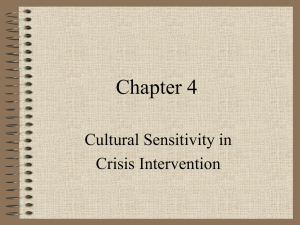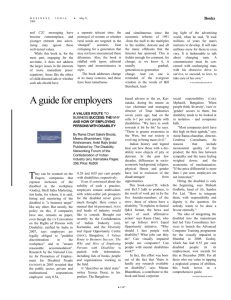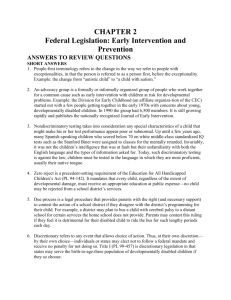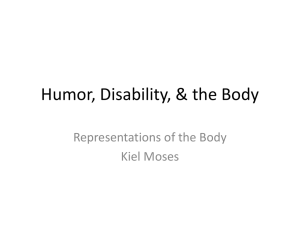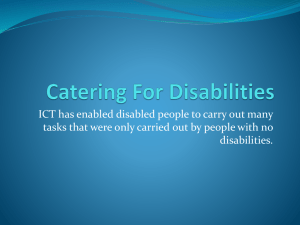Here is our latest briefing to the Minister of Disability Issues
advertisement
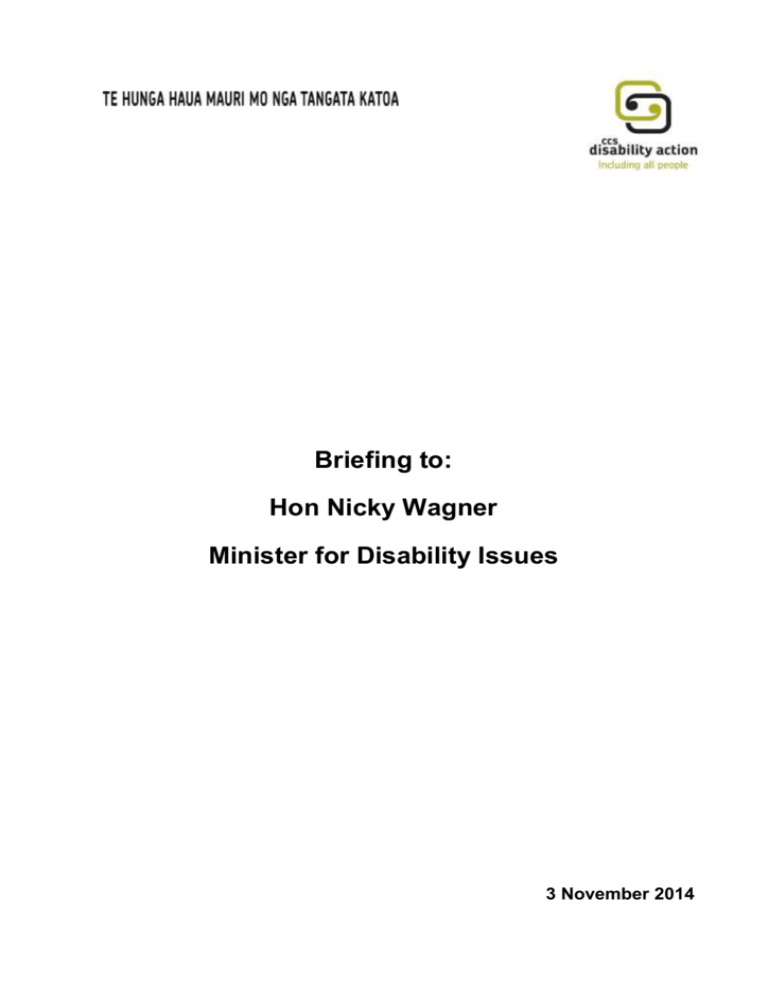
Briefing to: Hon Nicky Wagner Minister for Disability Issues 3 November 2014 1 Contents Introduction .......................................................................................................................... 2 About us............................................................................................................................... 3 Disabled New Zealanders do not get a fair go ..................................................................... 4 We need change 6 Discrimination and employer attitudes 7 Accessibility 7 Disabled children are amongst our most vulnerable children ............................................... 9 Disabled children are more likely to live in poverty 10 What we can do ................................................................................................................. 11 Look for community led solutions 11 Do not be afraid to ask the hard questions 11 Think about how people with disabilities might be affected by Law and policy 12 Think about long term options 12 Our advice ......................................................................................................................... 12 Thank you .......................................................................................................................... 13 2 Introduction CCS Disability Action is a community organisation that has been advocating for disabled people to be included in the community since 1935. Our vision We want to share our knowledge with you. We do not have all the answers, but we can provide you with advice and analysis to help you make better decisions. Disabled people are included in the life of their community and family. It has never been more vital that disabled people in New Zealand are included in the community. With the aging population, the number of disabled people is set to increase. Already disabled people make up almost a quarter of the population. We are running out of time to create an inclusive society. Key facts about Disability Being included in the community means disabled people have equal access to education, employment, buildings, infrastructure and transport. Disabled people need to have the same choices as non-disabled people, such as the choice of where to live and where to work. There are an estimated 1.1 million disabled New Zealanders, almost one in four of the population. There are an estimated 632,000 people with a physical impairment (14 per cent of the total population). There are an estimated 484,000 people with a sensory impairment (11 per cent of the total population). There are an estimated 95,000 disabled children aged under 15 (11 per cent of all children aged under 15). 53 per cent of disabled people have more than one impairment type. 3 About us We work with over 5,000 people with disabilities and their families. Our services support disabled people to be included in the life of their family and community. We receive a mixture of government funding and private donations. We provide services and advocacy from 16 local branches and 25 offices throughout the country. Our governance has strong disabled leadership and many of our staff members identify as disabled. Our advocacy is evidence-informed, honest and responsible. What unites and drives our organisation is a common philosophy. We believe that the community should value and include disabled people. 4 Disabled New Zealanders do not get a fair go Too often disabled people do not get a fair go. They do not get the same opportunities as non-disabled people. Disabled people do not always have equal access to Some of the costs of exclusion education, employment, buildings, infrastructure and transport. Last financial year, the As a result, some disabled people are excluded from the Government spent over $2 community. billion dollars supporting people on disability related This is bad for disabled people and wider society. benefits. Residential care for disabled Considerable money is spent on disability related services and people under 65 costs income support, but there is often poor outcomes for disabled around $485 million a year. people. Disabled people aged 15 to 44 have an unemployment In the 2013 Disability Survey, disabled people; rate of 14 per cent, compared to 7 per cent for were less likely to report a high level of life satisfaction; were less likely to feel safe at home or in their non-disabled people. neighbourhood; were twice as likely to be the victim of violent crime; more likely to report being discriminated against and more likely to be discriminated against more than three times over a twelve month period; more likely to have no qualification and less likely to have a bachelor's degree or higher; had higher unemployment and lower labour force participation; more likely to have lower incomes and live in lower income households, including for those aged under 65. We can do better and we must do better. A nation survives and thrives on how well it includes all its citizens in everyday life. 5 People reporting their life satisfaction - higher is more satisfied 80% 70% 60% 50% 40% Disabled people 30% Non-disabled people 20% 10% 0% 0–4.9 5–7.9 8–10 Highest qualification gained Disabled people Non-disabled people 37% 33% 32% 23% 15% No qualification 25% 23% 12% School qualification Post-school Bachelor's degree or at level 1 to 4 qualification at level higher 1 to 6 Total personal yearly income- aged 15+ 40% 35% 30% 25% 20% 15% 10% 5% 0% Disabled people Non-disabled people 6 We need change The discrimination and barriers people with impairments face are an issue for all of us. When disabled people are prevented from accessing the community and finding employment we all lose. With an aging population, the proportion of people in the labour force who have disabilities will increase. Exclusion costs us all. Statistics New Zealand’s median labour force projections has people over 65 making up 14 per cent of the labour force by 2036. In the 2013, Disability Survey people over 65 had a disability rate of 59 per cent, compared to 21 per cent of people aged 15 to 64. The future prosperity of New Zealand depends on our ability to include disabled people in education, employment and the community. Estimated percentage of labour force over 65 18% 16% 14% 12% 10% Estimated percentage of labour force over 65 8% 6% 4% 2% 2061 2056 2051 2046 2041 2036 2031 2026 2021 2016 2011 2006 0% 7 Researchers from Canada have estimated that reducing the unemployment rate amongst disabled people could increase GDP per capita by up to $600 Canadian dollars per year. They also found that increasing the education achievement rate of disabled people would generate an additional boost to GDP of $200 Canadian dollars per year. 1 These estimates were in Ontario. Ontario is, arguably, more advanced than New Zealand in terms of accessibility and human rights. This suggests our gains could be even higher. Discrimination and employer attitudes In a 2012 survey of employers, 78% said they believed disabled people were discriminated against in employment. 59% felt there were barriers that might stop disabled people from being employed in their own workplace. Only 21% felt there were none. Most employer believed these barriers were either difficult to address or insurmountable.2 Nearly all the employer in the research showed, at least outwardly, positive attitudes to disabled people. Nearly all employers believed that disabled people deserved a fair go and that their low rate of employment was an issue. These positive attitudes, however, seemed to have no effect on their willingness to hire disabled employees. Neither did knowing disabled people or having positive past experiences employing disabled people. Accessibility A major barrier to people accessing their community and finding employment is the inaccessibility of some buildings and public transport. In the 2012 survey of employers, 38% of employers said that there were physical barriers that stopped people with impairments from working at their work. A sizable number of people on government income support will be prevented, or discouraged, from working because of access barriers. 1 This research was commissioned by the Government of Ontario and can be found here: http://martinprosperity.org/2010/06/14/releasing-constraints-projecting-the-economic-impacts-of-increased-accessibility-inontario/ 2 This research was sponsored through the Think Differently Campaign and can be found here: http://www.thinkdifferently.org.nz/employer%20research 8 Accessibility issues affect everyone at some time in their life. We all experience different levels of mobility; sometimes due to temporary causes such as injury, pregnancy or sickness. As we age, it is increasingly due to more permanent causes such as impairments. With the aging population, there will be a growing diversity in mobility needs. Developing accessible infrastructure and transport will ensure that everyone can continue to live, work and fully participate in their chosen community. An Access Review has recently been completed and there is momentum to tackle the long-standing problems in access. There needs to be political will to drive changes, especially from you, the Minister for Disability Issues. 9 Disabled children are amongst our most vulnerable children Disabled children are more likely to live in low-income households, have fewer rights in current Law and experience serious discrimination in access to education. In the 2013 Disability Survey, disabled children were less likely to have done the following activities, in the previous four weeks, than non-disabled children were: had music, art, or other similar lessons; played a team sport; done other physical activity such as swimming or gymnastics; visited friends; been away on holiday in last 12 months. Only 77.8 per cent of disabled children had visited friends, over the previous four weeks, compared to 92 per cent of non-disabled children. Overseas research has found that Disabled children are at a higher risk of abuse. One of the most comprehensive studies to date, which took place in America, found children with disabilities were, when compared with children without disabilities: 3 3.8 times more likely to be neglected; 3.8 times more likely to be physically abused; 3.1 times more likely to be sexually abused.3 See the American Academy of Pediatrics article below or the recent Health Committee Inquiry into improving child health outcomes and preventing child abuse. http://pediatrics.aappublications.org/content/119/5/1018.long http://www.parliament.nz/en-nz/pb/sc/documents/reports/50DBSCH_SCR6007_1/inquiry-into-improving-child-health-outcomesand-preventing 10 Disabled children are more likely to live in poverty Disabled children are more likely to live in poorer families. The 2013 Disability Survey found that 34 per cent of disabled children live in families that earn under $50,000 a year, compared to only 24 per cent of non-disabled children. 17.7 per cent of disabled children live in households that earn under $30,000 a year, compared to 11.5 per cent of non-disabled children. Five per cent of disabled children live in households that earn under $15,001 a year, compared to 3.8 per cent of non-disabled children. The Ministry of Social Development’s 2012 Statistical Report found that: 37.5 per cent of caregivers receiving the child disability allowance are on a main benefit or superannuation. Disabled children - household income Less than $15,001 $15,001–$30,000 $50,001–$70,000 $70,001+ $30,001–$50,000 5% 13% 49% 16% 17% Non-disabled children - household income Less than $15,001 $15,001–$30,000 $50,001–$70,000 $70,001+ $30,001–$50,000 4% 8% 12% 59% 17% You cannot address child poverty or child abuse without addressing the issues disabled children face. 11 What we can do The issues affecting disabled people are complex and the government alone cannot solve all the issues. Government, however, has a key role to play. Government funded services and income support play a major role in the lives of many disabled people. We need to find ways to include disabled people in the community. As long as disabled people cannot freely access employment, education and the wider community, they, and New Zealand as a whole, will be significantly disadvantaged. This is a complex challenge. For example, here are just some of the issues stopping disabled people from finding employment: • attitudes of employers and fellow workers; • availability of suitable jobs in the local economy; • ability to make adjustments to the work place; • availability of flexible hours; • availability of formal and informal support networks; • a person’s access to education and work experience; • lack of accessible transport options and; • an inaccessible built environment. As Minister for Disability Issues you can play an important role. Below is some general advice about approaching disability issues. Look for community led solutions Disabled people and non-government organisations are often far more innovative and responsive than government departments. Sometimes all that is needed is for governments to give disabled people and non-government organisations room to innovate, rather than try to dictate change from above. Do not be afraid to ask the hard questions The disability sector, just like any sector, can lapse into jargon and good intentions without substance. Judge projects on their outcomes for disabled people, as well as principles. Do not be afraid to challenge ministries to be clear about their projects. 12 Think about how people with disabilities might be affected by Law and policy With an estimated 1.1 million disabled New Zealanders, nearly every law and policy will affect disabled people. Most of the issues disabled people face are connected to a wide range of government policies and beyond. Think about how different laws and policy interact. For example, accessibility requirements will affect the ability of people with access needs to find jobs. Think about long term options With the day-to-day pressure of being Member of Parliament, it is easy to lose sight of the overall picture. The 2008 Inquiry into the quality of care and service provision for people with disabilities recommended a lead agency be set up to coordinate disability services and policy. If this was ineffective, the Inquiry recommended an independent disability commission be established. At the time, the Government declined both recommendations, in favour of more immediate projects. While it important to carry out short and medium projects, it is important to have one eye on the long-term. Take a stand People look to you for leadership. Sometimes the Minister for Disability must stand for what is right, not what is convenient. This is what successive governments did when they dismantled the large-scale institutions disabled people use to live in. There is never going to be a perfect time to implement many changes, especially around inclusion. For example, several sections of the Children, Young Persons and Families Act give fewer rights to disabled children than non-disabled children. It has been acknowledge that this is wrong, but the time is never right to change it, or Ministries say more work must be done first. Our advice We are always happy to offer advice and analysis. Our advice is independent, evidenceinformed, frank and jargon free. 13 We have a diversity range of expertise across our organisations. We have staff members and governance with extensive experience in education, employment, housing, policy, care and protection issues, foster care, accessibility, local government, early family support, independent living and Māori disability issues. Thank you Thank you for taking the time to read this briefing. We look forward to seeing the difference you will make.


